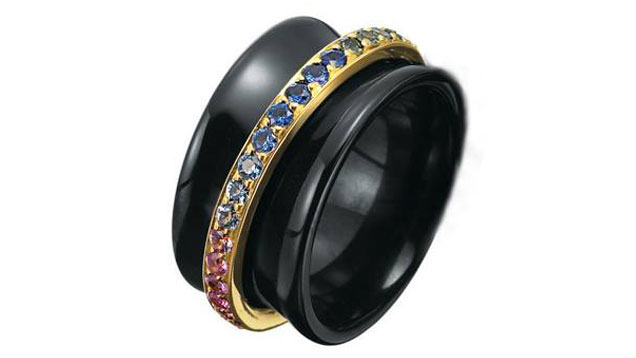Ceramic Ring Donation:
A Teaching Tool for Students

Designer Etienne Perret, GG, known for his colored diamond jewelry, is a pioneer in the use of ceramic as a cost-effective design alternative to platinum, gold and other precious metals. Perret’s innovative work will soon shine at GIA with the addition of a black concave Saturn ring from his Ceramique collection to the GIA museum – and eventually the Institute’s classrooms – this fall.
The 12mm-wide ring features an 18K yellow gold band that has been welded onto the ceramic and set with 36 heat-treated sapphires in a variety of colors. It is the first ceramic piece to be featured in the museum and the second donation from Perret, who earned his GG in his spare time through correspondence classes in the 1970s and 80s while working as a jewelry store owner and manager.
A desire to have ceramic jewelry represented at GIA made Perret decide to donate the ring. “I believe strongly in the GIA Museum,” he said. “I’ve gone to Carlsbad and spent time there and in the library. They’re fantastic for the jewelry world and the general public as well, and go far beyond benefiting the students.”
Perret’s work with ceramic extends the boundaries of what can be done with new materials and technology, according to Mark Maxwell, manager of the jewelry manufacturing arts program.
“He’s the most prominent name not only in the use of ceramic, but also in the contemporary metals field. This piece in platinum or gold would be double or triple the price,” Maxwell said. “In turning to ceramic, Perret is making fashion more affordable for today’s more cost-conscious times.”
Perret’s career spans decades and is marked by a number of accolades, including two Diamonds of Distinction awards, but it is his Ceramique collection that has been making waves in the jewelry industry in recent years. He perfected the art of working with the extremely hard gem-like substance using gem cutting tools to create ceramic designs in a variety of colors, although he prefers traditional black.
Perret uses zirconia ceramic, which is mined in an ecologically friendly manner and originates in the zircon sands of Australia. First developed for aerospace and other high-tech industries, it is used in everything from kitchen knives to dental and joint implants. With a rating of 8.7 on the Mohs scale, zirconia ceramic has a hardness that is nearly equal to that of sapphire, which gives it high durability and protects it from scratches and other damage.
“For our students, this donation is an incredible gift, and the plan is for the piece – like others before it – to eventually work its way into the classroom,” Maxwell said. “There’s no other educational institution in the world that gives its students the chance to not only see, but to also physically hold, creations such as this.”
It’s important for students to understand the history and innovations of the past and to also explore the new frontier that designers such as Perret represent, Maxwell added. “We’re thrilled to have the ring on display and available for our students to study.”
.jpg)


